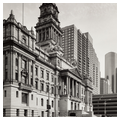You are here
Wayne County Building (Wayne County Courthouse)
This majestic civic building once faced Detroit's second city hall (demolished 1961) at Campus Martius on the west side of Woodward Avenue. Scott (1851–1928) designed the Wayne County Building in the Beaux-Arts classical style. Similar to this building, the Detroit city hall also had a prominent towered center with balancing end pavilions. The four-story, Berea sandstone courthouse is vigorously English Baroque in character. The main block rests on a raised, rusticated granite basement story and is surmounted by a four-tiered, colonnaded tower that is crowned by a curved hipped roof. A sandstone belt course encircles the building between the first and second stories, and a columned balustrade surrounds the building between the third and fourth stories. A broad flight of stairs fronts the central pavilion and leads to the two-story Corinthian-columned entrance portico. The courthouse is profusely ornamented with sculpture. The pediment of the portico contains a relief by Edward Wagner of Detroit of General “Mad” Anthony Wayne conferring with the Indians; flanking the portico are two bronze groups symbolizing Progress and Victory by John Massey Rhind of New York; and on the four sides of the tower are four female figures of Law, Commerce, Agriculture, and Mechanics.
The interior is finished in a variety of woods, marbles, tiles, and mosaics. The sumptuousness of the building, both inside and out, reflects Detroit's preeminence as the seat of county government—in fact, some thought Detroit the true capital of Michigan.
The last-minute decision of the county commissioners to build with light yellowish-brown Ohio rather than red Lake Superior sandstone disappointed owners of Upper Peninsula quarries, who had counted on John Scott, designer of many red sandstone buildings in the Upper Peninsula, to promote their stone. Unfortunately for them, with the advent of classicism, taste shifted to light-colored materials.
The courthouse was sold in 1984 to the Old Wayne County Building Limited Partnership, who restored and rehabilitated it, and then leased it back to Wayne County for use as executive, commission, and county agency offices. In December 2009, because of high rent, county officials moved to the Guardian Building ( WN12), and the partnership put the county building on the market.
Writing Credits
If SAH Archipedia has been useful to you, please consider supporting it.
SAH Archipedia tells the story of the United States through its buildings, landscapes, and cities. This freely available resource empowers the public with authoritative knowledge that deepens their understanding and appreciation of the built environment. But the Society of Architectural Historians, which created SAH Archipedia with University of Virginia Press, needs your support to maintain the high-caliber research, writing, photography, cartography, editing, design, and programming that make SAH Archipedia a trusted online resource available to all who value the history of place, heritage tourism, and learning.





